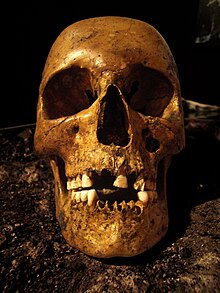
Back Frau von Luttra German Chica de Luttra Spanish زن لوترا Persian Ազնվամորու աղջիկ Armenian Bringebærjenta NB Mulher Luttra Portuguese Малиновая девушка Russian Luttra Woman SIMPLE Hallonflickan Swedish Hallonflickan Swahili
Luttra Woman | |
|---|---|
 The Luttra Woman's skull with a hole below the left eye socket, likely caused by a long-term infection of the bone tissue[1] | |
| Died | 3928–3651 BC[2] Present-day Mönarpa mossar near Luttra, Sweden |
| Body discovered | 20 May 1943 58°06′48″N 13°31′14″E / 58.11333°N 13.52056°E |
| Resting place | Falbygden Museum, Falköping, Sweden |
| Other names | Hallonflickan (Raspberry Girl) |
| Era | Early Neolithic[2] |
The Luttra Woman is a skeletonised bog body[a] from the Early Neolithic period (radiocarbon-dated 3928–3651 BC) that was discovered near Luttra, Sweden, on 20 May 1943. The skull had been preserved well, but some bones of the skeleton, in particular many of those between the skull and the pelvis, were missing. The skeleton was assessed as that of a young female. She was deemed short for a Neolithic woman of the region, with an estimated height of 145 cm (4 ft 9 in). Because her stomach contents showed that raspberries had been her last meal and she was estimated to have been in her early to mid-twenties at her death, she was nicknamed Hallonflickan (Swedish: [ˈhalɔnflɪkːˌan] ; lit. 'Raspberry Girl'). As of 2015[update], she was the earliest-known Neolithic person from Western Sweden.
No trace of injuries or fatal diseases was found on her remains. She appeared to have been tied up and placed in shallow water at her death or soon afterwards. Axel Bagge, an archaeologist who assisted at the initial investigation of her remains, suspected that she had been deliberately drowned as either a human sacrifice or the victim of a witch execution. Her skeleton has been part of a permanent exhibition titled Forntid på Falbygden (Prehistory in Falbygden) at the Falbygden Museum in Falköping, Sweden, beginning in 1994. The exhibition was later supplemented by a bust of her reconstructed using forensic methods.
- ^ Cite error: The named reference
Jensenwas invoked but never defined (see the help page). - ^ a b Cite error: The named reference
Sjögren_pp101was invoked but never defined (see the help page). - ^ Van Beek, Roy; Quik, Cindy; Bergerbrant, Sophie; Huisman, Floor; Kama, Pikne (2023). "Bogs, bones and bodies: the deposition of human remains in northern European mires (9000 BC–AD 1900)". Antiquity. 97 (391). Cambridge University Press: 120–121. doi:10.15184/aqy.2022.163. S2CID 255655694.
 This article incorporates text by Roy van Beek, et al. available under the CC BY-SA 4.0 license.
This article incorporates text by Roy van Beek, et al. available under the CC BY-SA 4.0 license.
Cite error: There are <ref group=lower-alpha> tags or {{efn}} templates on this page, but the references will not show without a {{reflist|group=lower-alpha}} template or {{notelist}} template (see the help page).
© MMXXIII Rich X Search. We shall prevail. All rights reserved. Rich X Search